Design for Seismic Resilient Cross Laminated Timber (CLT) Structures: A Review of Research, Novel Connections, Challenges and Opportunities
Abstract
:1. Introduction
2. CLT Shear Wall System and Conventional Connections
2.1. CLT Shear Wall System
2.2. Conventional CLT Connections
2.2.1. Experimental Studies
2.2.2. Analytical Models and Design Rules
2.3. Overview Conclusion
3. Innovative Connections for CLT Shear Walls
3.1. Innovative Connections for CLT Shear Wall Systems
3.2. Performance Evaluation for Novel CLT Connectors
3.2.1. Structural Performance
3.2.2. Constructability
3.2.3. Manufacturability
4. Novel Proposed Demountable Connection System for Multi-Storey CLT Buildings with Damage Avoidance Capacity
5. Conclusions
6. Future Perspectives
Author Contributions
Funding
Data Availability Statement
Acknowledgments
Conflicts of Interest
References
- Karacabeyli, E.; Gagnon, S. Canadian CLT Handbook, 1st ed.; FPInnovations: Pointe-Claire, QC, Canada, 2019; Volume 1. [Google Scholar]
- Hassanieh, A.; Valipour, H.; Bradford, M. Composite connections between CLT slab and steel beam: Experiments and empirical models. J. Constr. Steel Res. 2017, 138, 823–836. [Google Scholar] [CrossRef]
- Kurzinski, S.; Crovella, P.; Kremer, P. Overview of Cross-Laminated Timber (CLT) and Timber Structure Standards Across the World. Mass Timber Constr. J. 2022, 5, 1–13. [Google Scholar]
- Guo, H.; Liu, Y.; Meng, Y.; Huang, H.; Sun, C.; Shao, Y. A Comparison of the Energy Saving and Carbon Reduction Performance between Reinforced Concrete and Cross-Laminated Timber Structures in Residential Buildings in the Severe Cold Region of China. Sustainability 2017, 9, 1426. [Google Scholar] [CrossRef]
- Liu, Y.; Guo, H.; Sun, C.; Chang, W. Assessing Cross Laminated Timber (CLT) as an Alternative Material for Mid-Rise Residential Buildings in Cold Regions in China—A Life-Cycle Assessment Approach. Sustainability 2016, 8, 1047. [Google Scholar] [CrossRef]
- Svatoš-Ražnjević, H.; Orozco, L.; Menges, A. Advanced Timber Construction Industry: A Review of 350 Multi-Storey Timber Projects from 2000–2021. Buildings 2022, 12, 404. [Google Scholar] [CrossRef]
- Dehart, C. This is the World’s Largest CLT Building—And You’d Never Know It. 2018. Available online: https://gbdmagazine.com/worlds-largest-clt/ (accessed on 1 September 2022).
- WATTS GROVE. Ground Breaking Modular Housing. Available online: https://waughthistleton.com/watts-grove/ (accessed on 13 October 2022).
- Howarth, D. Penda Proposes Toronto Tree Tower Built from Cross-Laminated Timber Modules. 2017. Available online: https://www.dezeen.com/2017/08/02/toronto-tree-tower-penda-cross-laminated-timber-construction/ (accessed on 1 September 2022).
- Dreith, B. Icon Architects Unveils Design for Tallest Mass-Timber Building in North America. 2022. Available online: https://www.dezeen.com/2022/07/22/icon-architecture-tallest-mass-timber-building-north-america/ (accessed on 1 September 2022).
- Stepinac, M.; Šušteršič, I.; Gavric, I.; Rajčić, V. Seismic Design of Timber Buildings: Highlighted Challenges and Future Trends. Appl. Sci. 2020, 10, 1380. [Google Scholar] [CrossRef]
- Zhang, X.; Popovski, M.; Tannert, T. High-capacity hold-down for mass-timber buildings. Constr. Build. Mater. 2018, 164, 688–703. [Google Scholar] [CrossRef]
- Jorissen, A.; Fragiacomo, M. General notes on ductility in timber structures. Eng. Struct. 2011, 33, 2987–2997. [Google Scholar] [CrossRef]
- Soerensen, J.D. Framework for robustness assessment of timber structures. Eng. Struct. 2011, 33, 3087–3092. [Google Scholar] [CrossRef]
- Tannert, T.; Loss, C. Contemporary and Novel Hold-Down Solutions for Mass Timber Shear Walls. Buildings 2022, 12, 202. [Google Scholar] [CrossRef]
- Ceccotti, A.; Sandhaas, C.; Okabe, M.; Yasumura, M.; Minowa, C.; Kwai, N. SOFIE project-3D shaking table test on a seven-storey full-scale cross-laminated timber building. Earthq. Eng. Struct. Dyn. 2013, 42, 2003–2021. [Google Scholar] [CrossRef]
- Ceccotti, A. New Technologies for Construction of Medium-Rise Buildings in Seismic Regions: The XLAM Case. Struct. Eng. Int. J. Int. Assoc. Bridge Struct. Eng. 2008, 18, 156–165. [Google Scholar] [CrossRef]
- Carmen Sandhaas, A.C. Earthquake resistance of multi-storey massive timber buildings. In 2nd Forum Holzbau Beaunue; FORUM HOLZBAU: Biel, Switzerland, 2012. [Google Scholar]
- Popovski, M.; Gavric, I. Performance of a 2-Story CLT House Subjected to Lateral Loads. J. Struct. Eng. 2016, 142, E4015006. [Google Scholar] [CrossRef]
- Yasumura, M.; Kobayashi, K.; Okabe Miyake, T. Full-Scale Tests and Numerical Analysis of Low-Rise CLT Structures under Lateral Loading. J. Struct. Eng. 2016, 142, E4015007. [Google Scholar] [CrossRef]
- Matos, F.T.; Branco, J.M.; Rocha, P.; DemSchner, T.; Lourenço, P.B. Quasi-static tests on a two-story CLT building. Eng. Struct. 2019, 201, 109806. [Google Scholar] [CrossRef]
- Pozza, L.; Roberto, S.; Davide, T.; Pinna, M.; Polastri, A.; Beroni, P. Experimental and Numerical Analyses of New Massive Wooden Shear-Wall Systems. Buildings 2014, 4, 355–374. [Google Scholar] [CrossRef]
- Popovski, M.; Gavric, I.; Schneider, J. Performance of two-storey CLT house subjected to lateral loads. In Proceedings of the World Conference on Timber Engineering, Quebec City, QC, Canada, 14 August 2014. [Google Scholar]
- Gavric, I.; Fragiacomo, M.; Ceccotti, A. Cyclic behaviour of typical metal connectors for cross-laminated (CLT) structures. Mater. Struct. 2015, 48, 1841–1857. [Google Scholar] [CrossRef]
- Gavrić, I.; Fragiacomo, M.; Ceccotti, A. Capacity seismic design of X-LAM wall systems based on connection mechanical properties. In Proceedings of the 46th CIB-W18 Meeting, Vancouver, BC, Canada, 26–29 August 2013. [Google Scholar]
- Hristovski, V.; Dujic, B.; Stojmanovska, M.; Mircevska, V. Full-Scale Shaking-Table Tests of XLam Panel Systems and Numerical Verification: Specimen 1. J. Struct. Eng. 2013, 139, 2010–2018. [Google Scholar] [CrossRef]
- Hughes, C.; McPolinl, D.; McGerick, P.; McCrum, D. Behaviour of cross-laminated timber wall systems under monotonic lateral loading. J. Struct. Integr. Maint. 2019, 4, 153–161. [Google Scholar] [CrossRef]
- Gavric, I.; Fragiacomo, M.; Ceccotti, A. Cyclic behavior of typical screwed connections for cross-laminated (CLT) structures. Eur. J. Wood Wood Prod. 2015, 73, 179–191. [Google Scholar] [CrossRef]
- Tomasi, R.; Smith, I. Experimental Characterization of Monotonic and Cyclic Loading Responses of CLT Panel-To-Foundation Angle Bracket Connections. J. Mater. Civ. Eng. 2015, 27, 04014189. [Google Scholar] [CrossRef]
- Sandoli, A.; D’Ambra, C.; Ceraldi, C.; Calderoni, B.; Prota, A. Sustainable Cross-Laminated Timber Structures in a Seismic Area: Overview and Future Trends. Appl. Sci. 2021, 11, 2078. [Google Scholar] [CrossRef]
- Latour, M.; Rizzano, G. Cyclic Behavior and Modeling of a Dissipative Connector for Cross-Laminated Timber Panel Buildings. J. Earthq. Eng. JEE 2015, 19, 137–171. [Google Scholar] [CrossRef]
- Chan, N.; Hashemi, A.; Zarnani, P.; Quenneville, P. Pinching-Free Connector for Timber Structures. J. Struct. Eng. 2021, 147, 4021036. [Google Scholar] [CrossRef]
- Aloisio, A.; Pelliciari, M.; Berami, A.V.; Aloggio, R.; Briseghella, B.; Fragiaomo, M. Effect of pinching on structural resilience: Performance of reinforced concrete and timber structures under repeated cycles. Struct. Infrastruct. Eng. 2022, 1–17, ahead-of-print. [Google Scholar] [CrossRef]
- O’Ceallaigh, C.; Harte, A.M. The elastic and ductile behaviour of CLT wall-floor connections and the influence of fastener length. Eng. Struct. 2019, 189, 319–331. [Google Scholar] [CrossRef]
- EN 1998-1; Eurocode 8-Design of Structures for Earthquake Resistance-Part 1: General Rules, Seismic Actions and Rules for Buildings. European Committee for Standardisation: Brussels, Belgium, 2004.
- Yurrita, M.; Cabrero, J.M. On the need of distinguishing ductile and brittle failure modes in timber connections with dowel-type fasteners. Eng. Struct. 2021, 242, 112496. [Google Scholar] [CrossRef]
- Polastri, A.; Giongo, I.; Piazza, M. An Innovative Connection System for Cross-Laminated Timber Structures. Struct. Eng. Int. J. Int. Assoc. Bridge Struct. Eng. 2017, 27, 502–511. [Google Scholar] [CrossRef]
- Iacovidou, E.; Purnell, P. Mining the physical infrastructure: Opportunities, barriers and interventions in promoting structural components reuse. Sci. Total Environ. 2016, 557, 791–807. [Google Scholar] [CrossRef]
- Fragiacomo, M.; Dujic, B.; Sustersic, I. Elastic and ductile design of multi-storey crosslam massive wooden buildings under seismic actions. Eng. Struct. 2011, 33, 3043–3053. [Google Scholar] [CrossRef]
- Izzi, M.; Flatscher, G.; Fragiaomo, M.; Schickofer, G. Experimental investigations and design provisions of steel-to-timber joints with annular-ringed shank nails for Cross-Laminated Timber structures. Constr. Build. Mater. 2016, 122, 446–457. [Google Scholar] [CrossRef] [Green Version]
- Jorissen, A.J.M. Double Shear Timber Connections with Dowel Type Fasteners. Doctoral Thesis, Delft University of Technology, Delft, The Netherlands, 1998. [Google Scholar]
- Schickhofer, G.; Brandner, R.; Bauer, H. Introduction to CLT, product properties, strength classes. In Proceedings of the Joint Conference of COST Actions FP1402 & FP1404, Cross Laminated Timber-a Competitive Wood Product for Visionary and Fire Safe Buildings, Stockholm, Sweden, 10 March 2016. [Google Scholar]
- Izzi, M.; Casagrande, D.; Bezzi, S.; Pasca, D.; Follesa, M.; Tomasi, R. Seismic behaviour of Cross-Laminated Timber structures: A state-of-the-art review. Eng. Struct. 2018, 170, 42–52. [Google Scholar] [CrossRef]
- Follesa, M.; Fragiacomo, M.; Casagrande, D.; Piazza, M.; Vassallo, D.; Canetti, D.; Rossi, S. The new provisions for the seismic design of timber buildings in Europe. Eng. Struct. 2018, 168, 736–747. [Google Scholar] [CrossRef]
- EN 1995-1-1; Eurocode 5-Design of Timber Structures-Part 1-1: General Common Rules and Rules for Buildings. European Committee for Standardisation: Brussels, Belgium, 2004.
- Trutalli, D.; Marchi, L.; Scotta, R.; Pozza, L. Capacity design of traditional and innovative ductile connections for earthquake-resistant CLT structures. Bull. Earthq. Eng. 2019, 17, 2115–2136. [Google Scholar] [CrossRef]
- Mahlknecht, U.; Brandner, R. Block shear failure mechanism of axially-loaded groups of screws. Eng. Struct. 2019, 183, 220–242. [Google Scholar] [CrossRef]
- Pozza, L.; Saetta, A.; Savoia, M.; Talledo, D. Angle bracket connections for CLT structures: Experimental characterization and numerical modelling. Constr. Build. Mater. 2018, 191, 95–113. [Google Scholar] [CrossRef]
- Liu, J.; Lam, F. Experimental test of coupling effect on CLT angle bracket connections. Eng. Struct. 2018, 171, 862–873. [Google Scholar] [CrossRef]
- Marchi, L. Innovative Connection Systems For Timber Structures. Doctoral Thesis, The University of Padua, Padua, Italy, 2018. [Google Scholar]
- Schneider, J.; Karacabeyli, E.; Popovski, M.; Stiemer, S.F.; Tesfamariam, S. Damage Assessment of Connections Used in Cross-Laminated Timber Subject to Cyclic Loads. J. Perform. Constr. Facil. 2014, 28, 4014008. [Google Scholar] [CrossRef]
- Izzi, M.; Polastri, A.; Fragiacomo, M. Modelling the mechanical behaviour of typical wall-to-floor connection systems for cross-laminated timber structures. Eng. Struct. 2018, 162, 270–282. [Google Scholar] [CrossRef]
- Polastri, A.N.; Pozza, L. Proposal for a Standardized Design and Modeling Procedure of Tall clt buildings. Int. J. Qual. Res. 2016, 10, 607–624. [Google Scholar]
- Yurrita, M.; Cabrero, J.M. New design model for brittle failure in the parallel-to-grain direction of timber connections with large diameter fasteners. Eng. Struct. 2020, 217, 110557. [Google Scholar] [CrossRef]
- Zarnani, P.; Quenneville, P. New design approach for controlling brittle failure modes of small-dowel-type connections in Cross-laminated Timber (CLT). Constr. Build. Mater. 2015, 100, 172–182. [Google Scholar] [CrossRef]
- Hanhijärvi, A.; Kevarinmäki, A. Design Method against Timber Failure Mechanisms of Dowelled Steel-to-Timber Connections; CIB-W18 Timber Structures: Bled, Slovenia, 2007; p. 40-7-3. [Google Scholar]
- Yurrita, M.; Cabrero, J.M.; Quenneville, P. Brittle failure in the parallel-to-grain direction of multiple shear softwood timber connections with slotted-in steel plates and dowel-type fasteners. Constr. Build. Mater. 2019, 216, 296–313. [Google Scholar] [CrossRef]
- Marchi, L.; Trutalli, D.; Scotta, R.; Pozza, L. Nnumerical simulation of the coupled Tension-Shear response of an innovative dissapative connection for CLT buildings. In Proceedings of the 6th ECCOMAS Thematic Conference on Computational Methods in Structural Dynamics and Earthquake Engineering, Rhodes Island, Greece, 15–17 June 2017; pp. 247–254. [Google Scholar]
- Polastri, A.; Giongo, I.; Angeli, A.; Brandner, R. Mechanical characterization of a pre-fabricated connection system for cross laminated timber structures in seismic regions. Eng. Struct. 2018, 167, 705–715. [Google Scholar] [CrossRef]
- Rothoblaas. X-RAD: X-RAD Connection System. Available online: https://www.rothoblaas.com/products/fastening/brackets-and-plates/x-rad/x-rad (accessed on 6 July 2022).
- Kraler, A.; Kögl, J.; Maderebner, R.; Flach, M. SHERPA-CLT-Connector for Cross Laminated Timber (CLT) Elements. 2013. In Proceedings of the 13th World Conference on Timber Engineering (WCTE2014), Quebec City, QC, Canada, 14 August 2014. [Google Scholar]
- Shao, F.; Wang, Y.; Lian, W.; Benjeddou, O. Experimental and numerical investigation on withdrawal connectors usage for lateral resistance of timber shear walls structure. J. Build. Eng. 2021, 44, 103266. [Google Scholar] [CrossRef]
- Hashemi, A.; Zarnani, P.; Masoudnia, R.; Quenneville, P. Experimental Testing of Rocking Cross-Laminated Timber Walls with Resilient Slip Friction Joints. J. Struct. Eng. 2018, 144, 4017180. [Google Scholar] [CrossRef]
- Hashemi, A.; Zarnani, P.; Quenneville, P. Earthquake resistant timber panelised structures with resilient connections. Structures 2020, 28, 225–234. [Google Scholar] [CrossRef]
- Hashemi, A.; Masoudnia, R.; Quenneville, P. Seismic performance of hybrid self-centring steel-timber rocking core walls with slip friction connections. J. Constr. Steel Res. 2016, 126, 201–213. [Google Scholar] [CrossRef]
- Hashemi, A.; Zarnani, P.; Masoudnia, R.; Quenneville, P. Seismic resistant rocking coupled walls with innovative Resilient Slip Friction (RSF) joints. J. Constr. Steel Res. 2017, 129, 215–226. [Google Scholar] [CrossRef]
- Fitzgerald, D.; Sinha, A.; Miller, T.H.; Nairn, J.A. Axial slip-friction connections for cross-laminated timber. Eng. Struct. 2021, 228, 111478. [Google Scholar] [CrossRef]
- Fitzgerald, D.; Miller, T.H.; Sinha, A.; Nairn, J.A. Cross-laminated timber rocking walls with slip-friction connections. Eng. Struct. 2020, 220, 110973. [Google Scholar] [CrossRef]
- Latour, M.; Rizzano, G. Experimental Behavior and Mechanical Modeling of Dissipative T-Stub Connections. J. Struct. Eng. 2012, 138, 170–182. [Google Scholar] [CrossRef]
- Zhang, X. Seismic Design of Timber Steel Hybrid High-Rise Buildings; University of British Columbia: Vancouver, BC, Canada, 2017. [Google Scholar]
- Schneider, J.; Tannert, T.; Tesfamariam, S.; Stiemer, S. Experimental assessment of a novel steel tube connector in cross-laminated timber. Eng. Struct. 2018, 177, 283–290. [Google Scholar] [CrossRef]
- Mpidi Bita, H.; Tannert, T. Numerical optimisation of novel connection for cross-laminated timber buildings. Eng. Struct. 2018, 175, 273–283. [Google Scholar] [CrossRef]
- Wrzesniak, D.; Rodgers, G.W.; Fragiacomo, M.; Chase, J.G. Experimental testing of damage-resistant rocking glulam walls with lead extrusion dampers. Constr. Build. Mater. 2016, 102, 1145–1153. [Google Scholar] [CrossRef]
- Rodgers, G.W.; Mander, J.B.; Chase, J.G. Precision Design Modelling of HF2V Devices. Structures 2018, 14, 243–250. [Google Scholar]
- Vishnupriya, V.; Rodgers, G.W.; Chase, J.G. Nonlinear Finite-Element Modeling of HF2V Lead Extrusion Damping Devices: Generic Design Tool. J. Struct. Eng. 2022, 148, 04021227. [Google Scholar] [CrossRef]
- Dires, S.; Tannert, T. Performance of coupled CLT shear walls with internal perforated steel plates as vertical joints and hold-downs. Constr. Build. Mater. 2022, 346, 128389. [Google Scholar] [CrossRef]
- Kramer, A.; Barbosa, A.R.; Sinha, A. Performance of Steel Energy Dissipators Connected to Cross-Laminated Timber Wall Panels Subjected to Tension and Cyclic Loading. J. Struct. Eng. 2016, 142, E4015013. [Google Scholar] [CrossRef]
- Araya, R.; Montaño, J.; Guindos, P. Experimental Test of The Gap Reinforced Fastened Connection (GRFC): A highly stiff and ductile reinforced connection concept with reduced pinching for timber structures. Eng. Struct. 2022, 251, 113584. [Google Scholar] [CrossRef]
- Li, Z.; Wang, X.; He, M.; Shu, Z.; Huang, Y.; Wu, A.; Ma, Z. Mechanical performance of pre-fabricated metal dovetail connections for Cross-Laminated Timber (CLT) structures. Constr. Build. Mater. 2021, 303, 124468. [Google Scholar] [CrossRef]
- Rothoblaas. LOCK Floor: Joint Profile for CLT Panels. Available online: https://www.rothoblaas.com/products/fastening/brackets-and-plates/concealed-connections/lock-floor (accessed on 6 September 2020).
- Carrero, T.; Montaño, J.; Berwart, S.; María, H.S.; Guindos, P. Seismic behavior of innovative hybrid CLT-steel shear wall for mid-rise buildings. Bull. Earthq. Eng. 2021, 19, 5917–5951. [Google Scholar] [CrossRef]
- Iqbal, A.; Pampanin, S.; Palermo, A.; Buchanan, A.H. Performance and Design of LVL Walls Coupled with UFP Dissipaters. J. Earthq. Eng. JEE 2015, 19, 383–409. [Google Scholar] [CrossRef]
- Baird, A.; Smith, T.; Palermo, A.; Pampanin, S. Experimental and numerical Study of U-shape Flexural Plate (UFP) dissipators. In New Zealand Society for Earthquake Engineering 2014 Technical Conference and AGM; New Zealand Society for Earthquake Engineering: Auckland, New Zealand, 2014. [Google Scholar]
- Srisangeerthanan, S.; Hashemi, M.J.; Rajeev, P.; Gad, E.; Fernando, S. Review of performance requirements for inter-module connections in multi-story modular buildings. J. Build. Eng. 2020, 28, 101087. [Google Scholar] [CrossRef]
- Corfar, D.-A.; Tsavdaridis, K.D. A comprehensive review and classification of inter-module connections for hot-rolled steel modular building systems. J. Build. Eng. 2022, 50, 104006. [Google Scholar] [CrossRef]
- Smith, R.E.; Griffin, G.; Rice, T.; Hagehofer-Daniell, B. Mass timber: Evaluating construction performance. Arch. Eng. Des. Manag. 2018, 14, 127–138. [Google Scholar] [CrossRef]
- Li, Z.; Tsavdaridis, K.D. Limited-damage 3D-printed interlocking connection for timber volumetric structures: Experimental validation and computational modelling. J. Build. Eng. 2023, 63, 105373. [Google Scholar] [CrossRef]
- Li, Z.; Tsavdaridis, K.D.; Gardner, L. A Review of Optimised Additively Manufactured Steel Connections for Modular Building Systems. In Proceedings of the Additive Manufacturing for Products and Applications, Zurich, Switzerland, 1–3 September 2020. [Google Scholar]
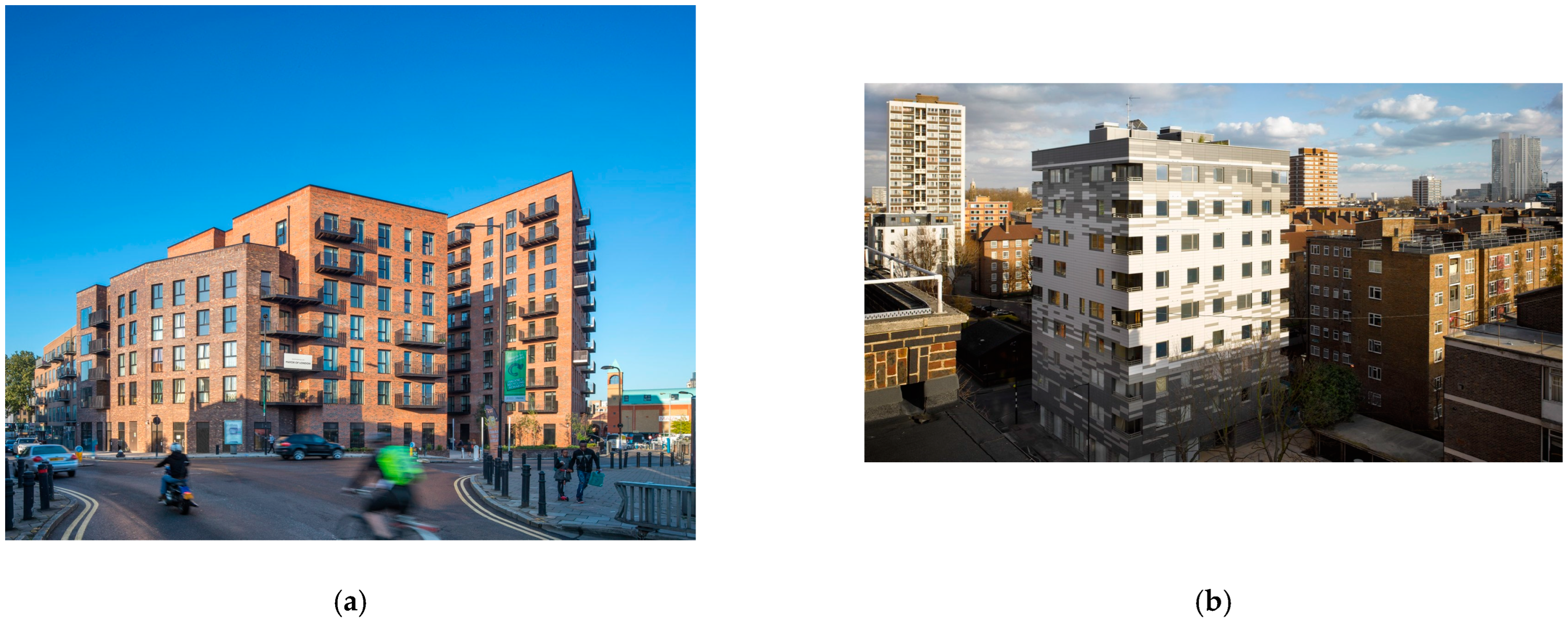
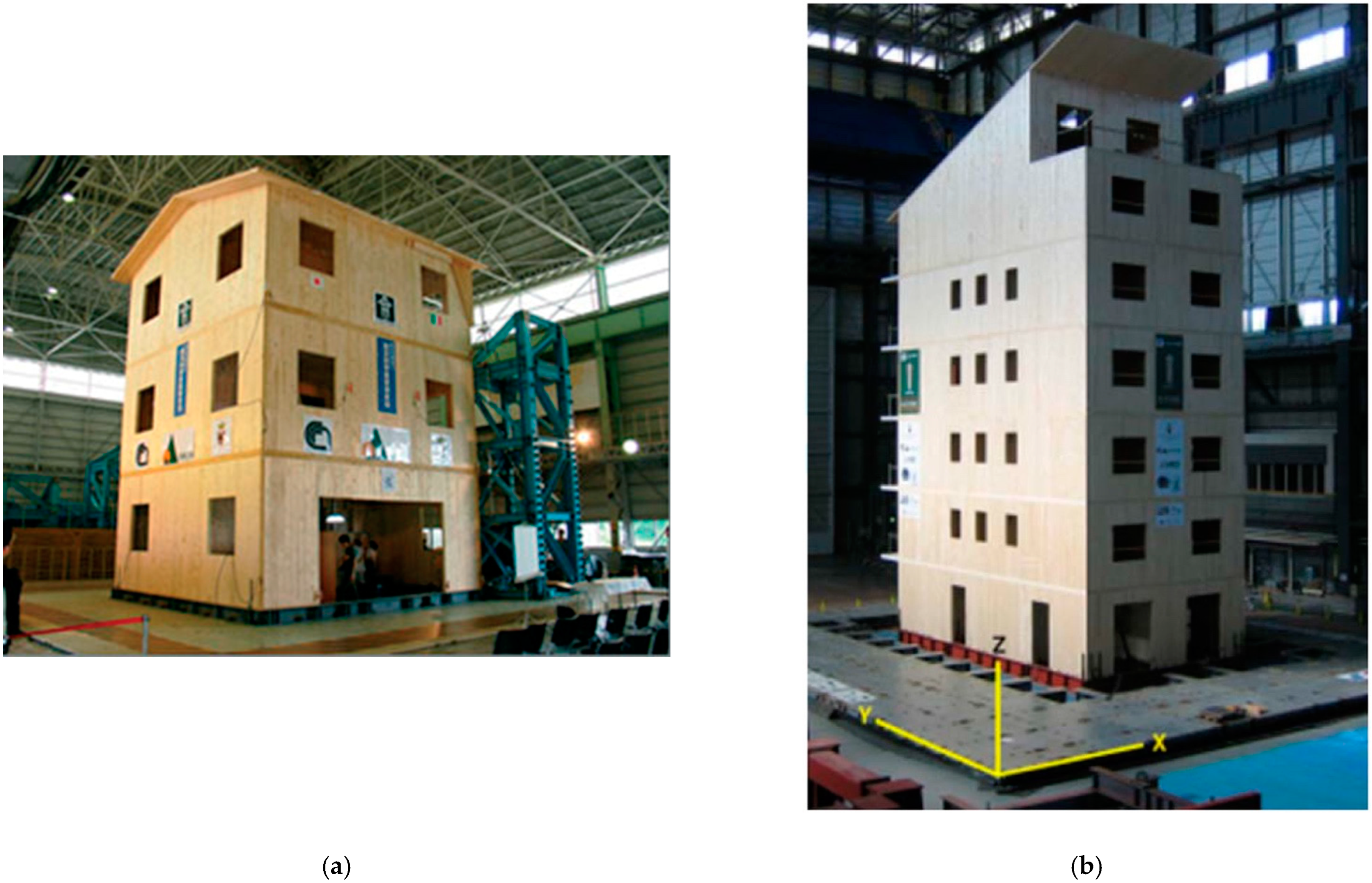
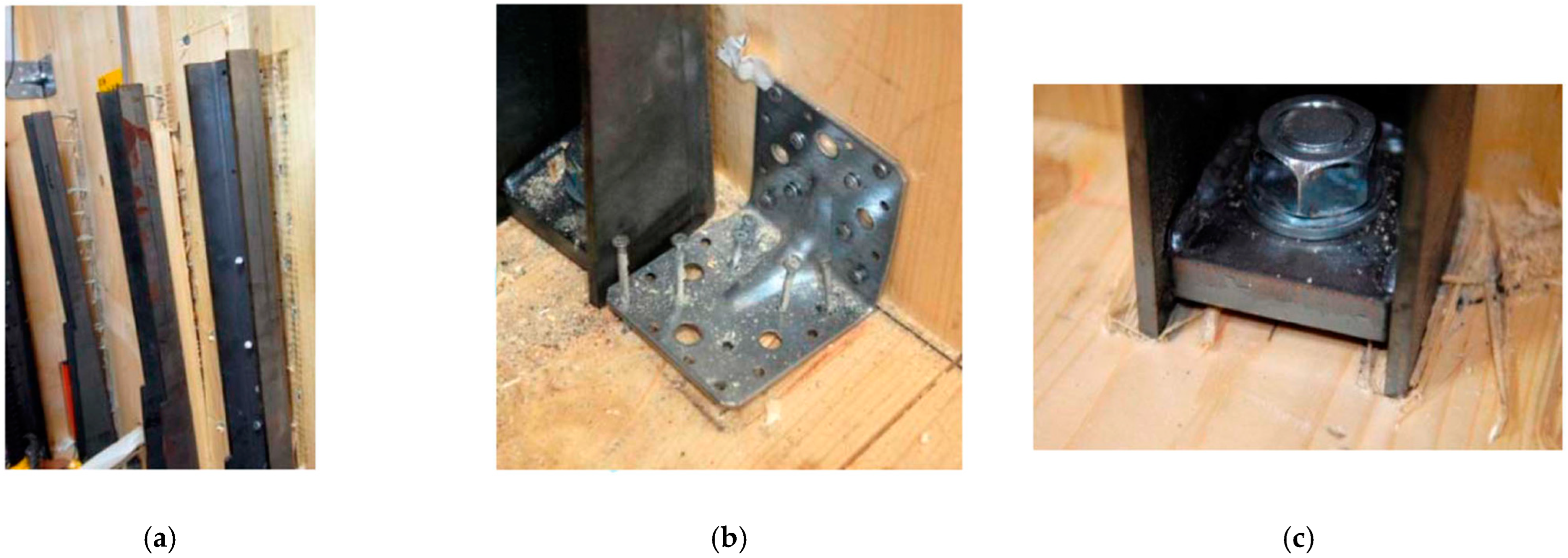
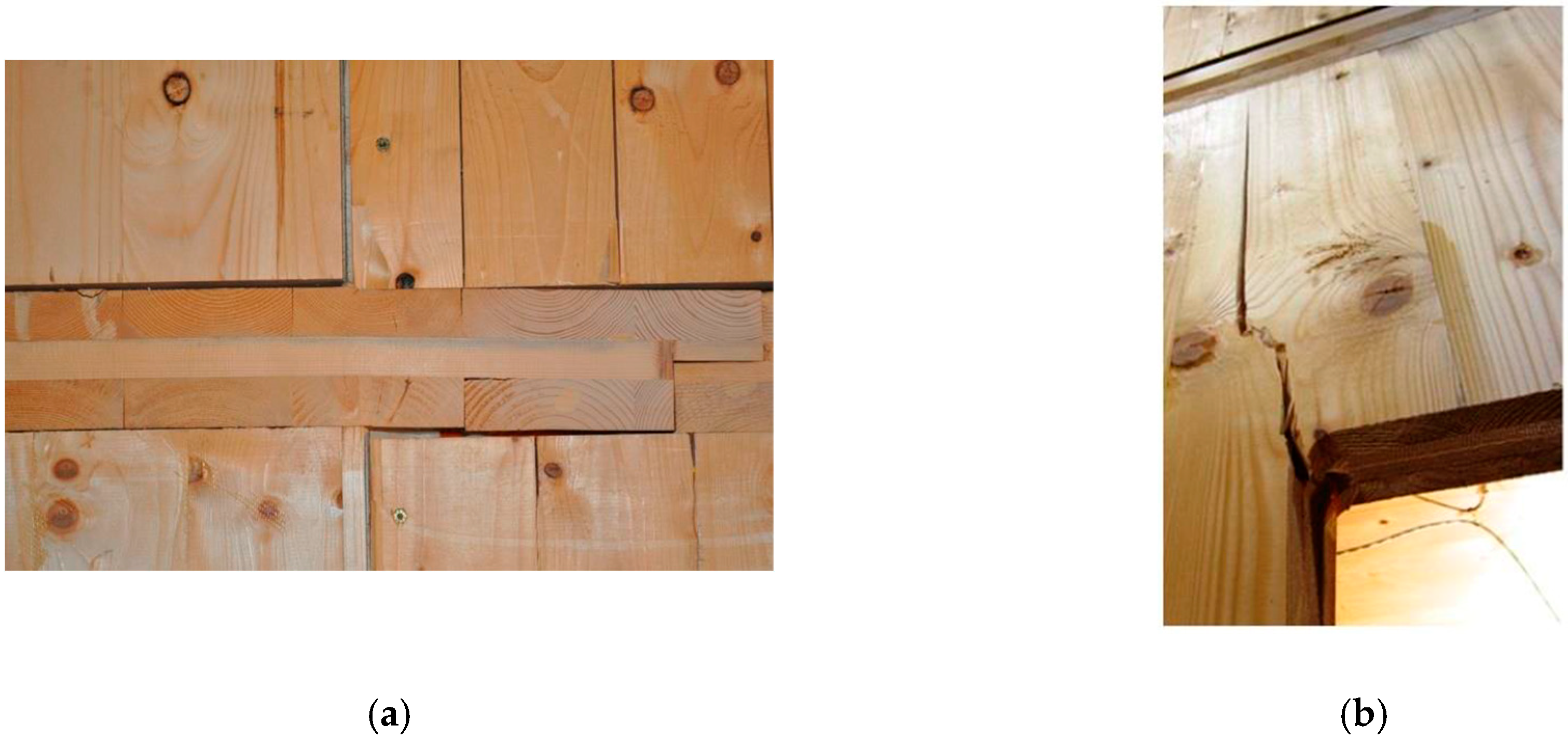

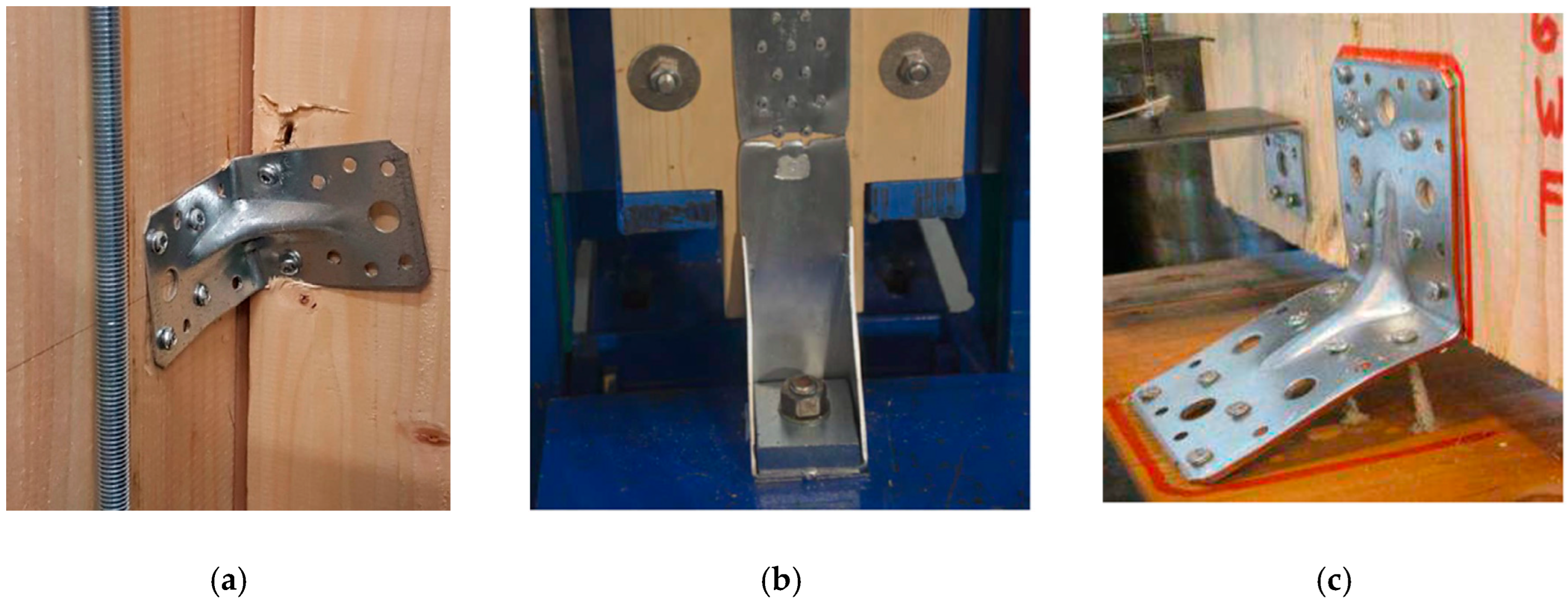
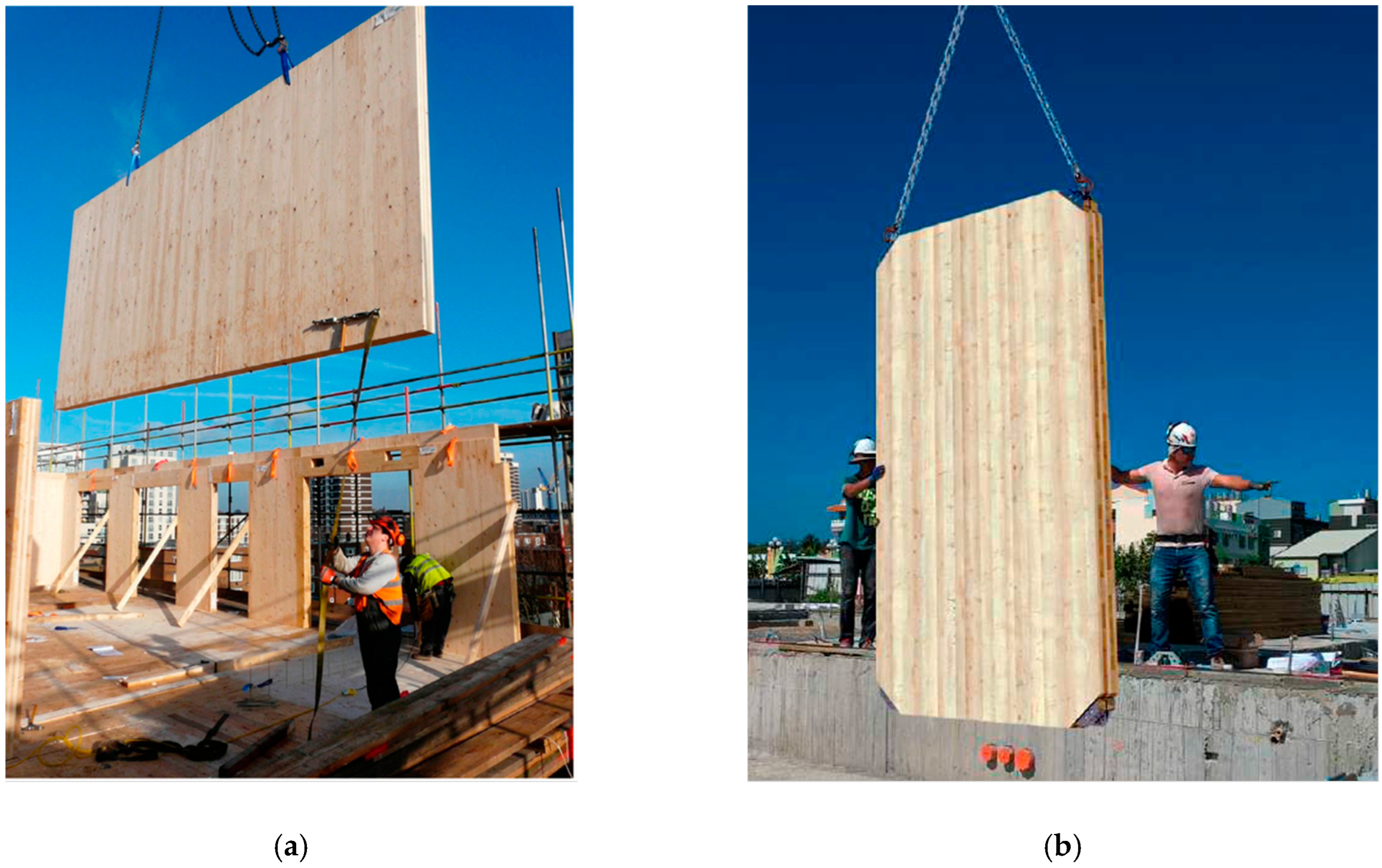
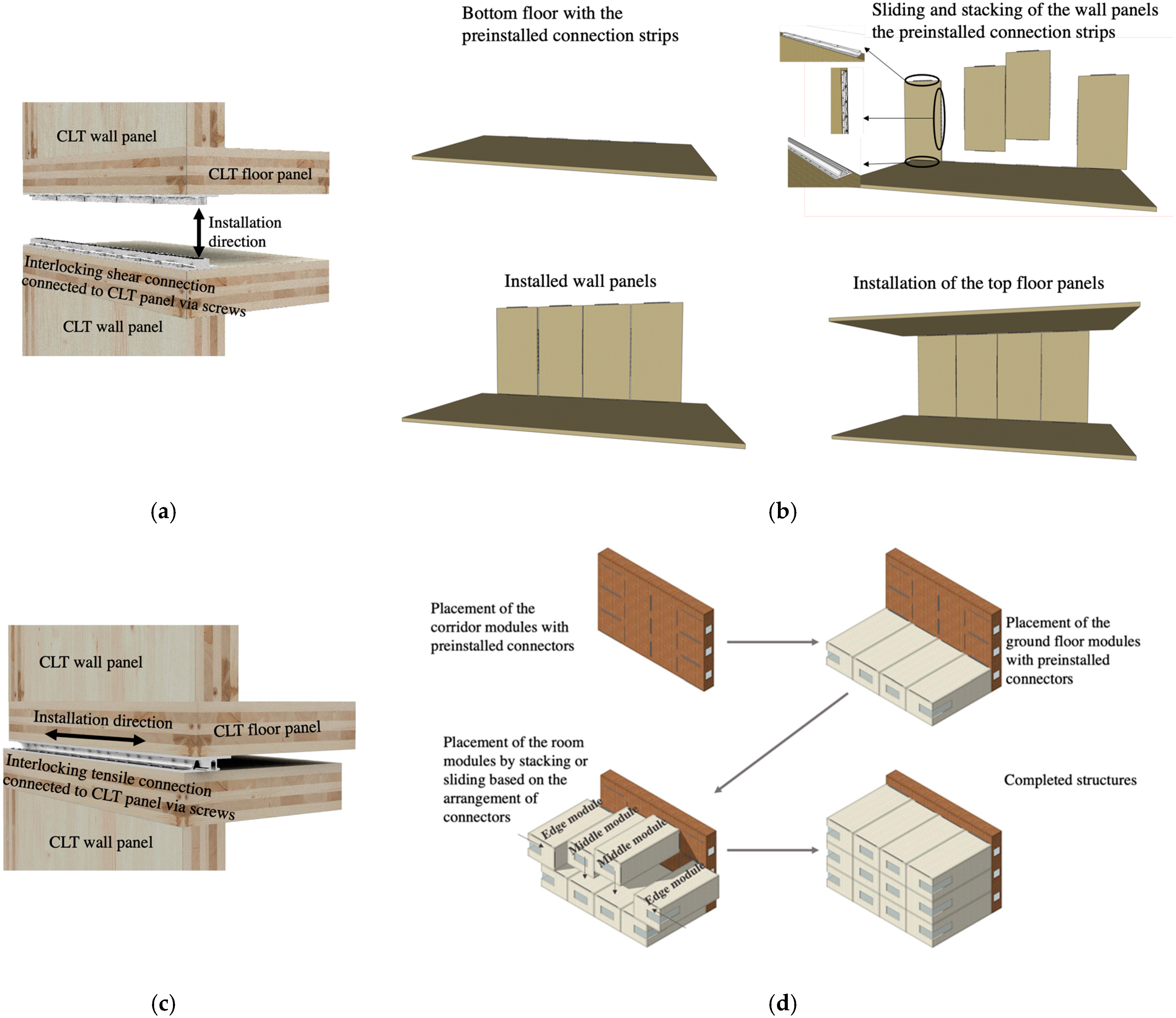
| Index | Name | Connection Figures | Descriptions | Ref |
|---|---|---|---|---|
| Connector For CLT panels (CLT-C) | ||||
| CLT-C1 | X-bracket |  | The X-bracket is a novel steel bracket designed for providing CLT buildings with improved ductility and energy dissipative capacity in both shear and tensile directions, as well as for reducing permanent damage in timber, strength degredation and the pinching effect. | [46,50,58] |
| CLT-C2 | The X-RAD from Rothoblaas Ltd. |  | The X-RAD is a multi-directional point-to-point connection that links wall and floor CLT panels, which is easy to assemble and disassemble but requires precise profiling and fitting. With the inclined screws and the linking metal panels, this connector is characterised by a high strength and stiffness and an adequate ductility. | [37,59,60] |
| CLT-C3 | SHERPA-CLT-connector | The SHERPA-CLT-connector is a coupling element that can be used in the angle joint, t-joint and longitudinal joint of CLT panels. It is designed for safe and high-precision assembly without the need for any scaffolding, as the connectors are placed in the interior of buildings. | [61,62] | |
| CLT-C4 | Pinch-free Connector (PFC) | The PFC is a novel tensile connector which is designed to overcome the pinched effect in conventional timber connections, with an improved reload stiffness and a better hysteresis performance. The equipped preloaded spring ensures the permanent contact between the timber and connector, therefore eliminating the crushing-induced slack through a ratcheting mechanism. | [32] | |
| CLT-C5 | Slip-friction connector (Tectonus) | 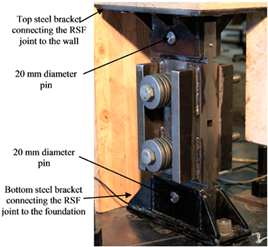 | The Tectonus is a friction tensile connector which allows for rocking and fully self-centring behaviours in CLT shear walls. It can dissipate energy via friction and effectively eliminate the slip between the connected elements. This system has recently been commercialised and applied in the newly built ‘Fast+Epp’ building in Vancouver [15]. | [63,64,65,66] |
| CLT-C6 | Shear key with slots |  | This is a novel type of shear transferring device that is designed along with CLT-C5 for the rocking shear wall behaviour. It behaves similarly to angle bracket connections when working in the shear, while the slots with a special shape allow for uplifting during the rocking of CLT panels. | [63,64,65,66] |
| CLT-C7 | Slip-friction connector (Slotted-bolted connection) | 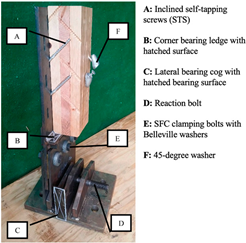 | This slip-friction connector (SFC) is a vertical connector that is made with steel plates clamping together with slotted bolt holes and fixed to timber with inclined self-tapping screws. A certain degree of linear movement is allowed in this connector to achieve a great energy dissipative performance with limited strength degradation. | [67,68] |
| CLT-C8 | XL-stubs | The XL-stubs are modified hold-downs with hourglass steel plates for replacing the original rectangular steel plates. The reduced area at the middle of the hourglass steel plate can help trigger deformation during loading and reduce plastic deformation in timber, thus achieving an improved energy dissipation capacity. | [31,69] | |
| CLT-C9 | Holz–Stahl–Komposit (HSK) System |  | The Holz–Stahl–Komposit (HSK) System is a shear connector formed by steel plates that are inserted into timber and bonded with chemical adhesive. Duct-tape is used with this connector to prevent the formation of an adhesive bond in specific areas, creating a ’weak zone’ that can act as a yielding fuse. | [12,70] |
| CLT-C10 | Novel tube connector | 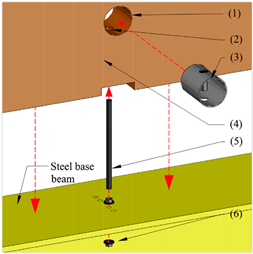 | This tube connector is a hollow steel tube placed within the hole drilled on CLT panels, connecting panels to the foundation by a threaded rod that goes through the panels. Apart from the improved mechanical performance, this connector is also designed for limited timber damage and easy installation and replacement. | [71,72] |
| CLT-C11 | High-Force-to-Volume (HF2V) damping devices |  | The HF2V damping device is a substitute for the conventional tensile connections, with loading resistance and energy dissipation being provided by the reversible plastic extrusion of lead. It also enables the self-centring of shear walls with insignificant damage in both the device and timber and can therefore be fully reused. | [73,74,75] |
| CLT-C12 | Internal-perforated-steel-plate (IPSP) connections with self-drilling dowels (SDD) | 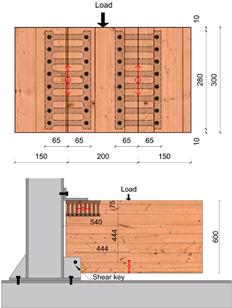 | This is a modified IPSP connector that joints timber panels using SDD instead of adhesive. It can be transformed into hold-downs and panel-to-panel connectors. The reduced area of the steel plate (steel bridge) is a designated weak area that is to deform first to prevent the bending of SDD and the crushing of timber. | [76] |
| CLT-C13 | Energy dissipators with steel buckling restrained steel braces (BRB) concept | 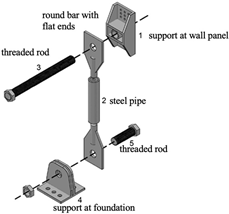 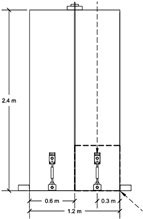 | This connector is an energy dissipater for CLT panels that has a milled portion enclosed in a grouted steel pipe that is designed to yield first in the connector. An end-pinned system is included in the connector to allow for rotation at the ends of the energy dissipators and reduce internal moments. | [77] |
| CLT-C14 | Gap Reinforced Fastened Connector (GRFC) | The GRFC is a modified hold-down that incorporates a gap between two steel plates that are bonded by adhesive. The gap creates space for the yielding of fasteners, thus reducing the crushing on timber during deformation. The adhesive layer creates a rigid interface between fasteners, reducing the connections space requirements in EC5. | [78] | |
| CLT-C15 | Prefabricated Metal Dovetail Connector |  | The prefabricated metal dovetail connector consists of a mortise part and a tenon part, and it is designed for the screw-free onsite installation of CLT panels. | [79] |
| CLT-C16 | LOCK Connector from Rothoblaas Ltd. |  | The LOCK connector system is a concealed connector for the easy and accurate joining of CLT panels to a concrete foundation by sliding, which also provides convenient disassembly after the end-of-life of structures. By varying the length of the connector, this system can be used on both CLT panels and beams. | [80] |
| CLT shear wall reinforcement systems (CLT-R) | ||||
| CLT-R1 | Framing Panel Shear Walls (FPSW) | 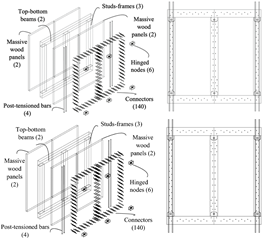 | FPSW is a hybrid shear wall system formed by CLT panels, articulated hollow steel bracing and steel tendons. This system provides a reduced overturning effect and an improved structural performance compared to conventional CLT shear walls. The steel frame ensures structural integrity when the load-bearing CLT panels are damaged, thus allowing for low-cost rehabilitation. | [81] |
| CLT-R2 | Post tensioned hybrid shear wall with U-shaped flexural plates (UFPs) |  | This hybrid shear wall system is reinforced by prestressed tendons and energy dissipating devices (UFPs). Re-centring and sufficient energy dissipation can be achieved in this system through metal yielding with litter timber damage, which allows for low-cost repair by replacing the sacrificial UFPs after seismic events. | [82,83] |
| Index | Connection Type | Fasteners Type | Scale of Testing | Loading Protocol | Ductility Factor | Deformation and Failure Modes |
|---|---|---|---|---|---|---|
| CLT-C1 | Angle bracket (Shear) | 4*M16 bolts | Local/Macro | Cyclic | 23.43 | 
|
| Hold-down (Tension) | Local/Macro | Cyclic | 23.57 | 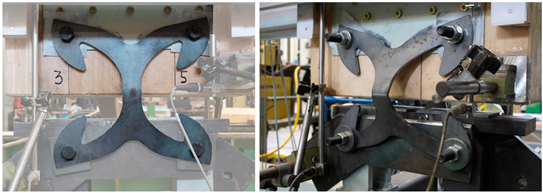
| ||
| CLT-C2 | Angle bracket (Shear) | mm Inclined screws and M12 bolts | Local/Macro | Monotonic/Cyclic | 2 | 
|
| Hold-down (Tension) | Monotonic/Cyclic | 6.3 | 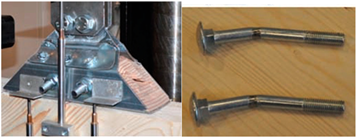
| |||
| CLT-C4 | Hold-down (Tension) | 4*M10/2*M16 bolts | Local/Macro | Cyclic | 10 | 
|
| CLT-C5 | Hold-down (Tension) | mm screws | Local/Macro | Cyclic | N/A | 
|
| CLT-C6 | Angle bracket (Shear) | 8*M20 bolts | Macro | Cyclic | N/A | 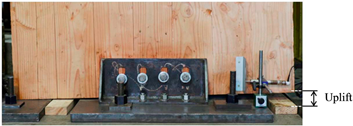
|
| CLT-C7 | Hold-down (Tension) | mm screws | Local/Macro | Cyclic | N/A | 
|
| CLT-C8 | Hold-down (Tension) | 8*M12 bolts and 2*M18 bolts | Local | Monotonic/Cyclic | 52.2 | 
|
| CLT-C9 | Hold-down (Tension) & panel-to-panel connection (Shear) | Adhesive | Local/Macro | Monotonic/Cyclic | 31.8 | 
|
| CLT-C10 | Hold-down (Tension) | mm threaded rod and 2* nuts rods | Local | Monotonic/Cyclic | 4–8.7 | 
|
| CLT-C12 | Panel-to-panel connection (Shear) | mm screws | Local/Macro | Monotonic/Cyclic | 14.5 | 
|
| Hold-down (Tension) | mm screws | Local/Macro | Monotonic/Cyclic | 22.1 | 
| |
| CLT-C13 | Hold-down (Tension) | mm screws, 1* threaded rod and 1*25.4 mm bolt | Local | Monotonic/Cyclic | N/A | 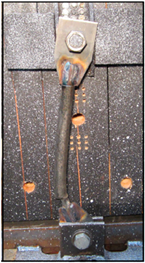
|
| CLT-C14 | Hold-down (Tension) | mm nails | Local | Monotonic/Cyclic | 0.44–2.55 | 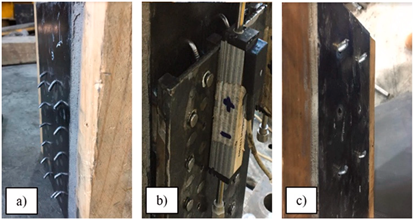
|
| CLT-C15 | Hold-down (Compression) | mm screws | Local | Monotonic/Cyclic | 4.67 | 
|
| Angle bracket (Shear) | Monotonic/Cyclic | 1.67 | 
| |||
| CLT-R1 | Shear wall system | mm bolts | Local/Macro | Cyclic | 4.83 | 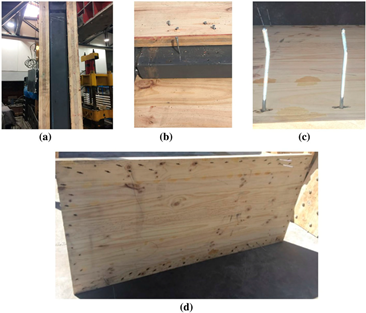
|
| CLT-R2 | Shear wall system | mm tenons and self-drilling screws | Local/Macro | Cyclic | N/A | 
|
Disclaimer/Publisher’s Note: The statements, opinions and data contained in all publications are solely those of the individual author(s) and contributor(s) and not of MDPI and/or the editor(s). MDPI and/or the editor(s) disclaim responsibility for any injury to people or property resulting from any ideas, methods, instructions or products referred to in the content. |
© 2023 by the authors. Licensee MDPI, Basel, Switzerland. This article is an open access article distributed under the terms and conditions of the Creative Commons Attribution (CC BY) license (https://creativecommons.org/licenses/by/4.0/).
Share and Cite
Li, Z.; Tsavdaridis, K.D. Design for Seismic Resilient Cross Laminated Timber (CLT) Structures: A Review of Research, Novel Connections, Challenges and Opportunities. Buildings 2023, 13, 505. https://doi.org/10.3390/buildings13020505
Li Z, Tsavdaridis KD. Design for Seismic Resilient Cross Laminated Timber (CLT) Structures: A Review of Research, Novel Connections, Challenges and Opportunities. Buildings. 2023; 13(2):505. https://doi.org/10.3390/buildings13020505
Chicago/Turabian StyleLi, Zhengyao, and Konstantinos Daniel Tsavdaridis. 2023. "Design for Seismic Resilient Cross Laminated Timber (CLT) Structures: A Review of Research, Novel Connections, Challenges and Opportunities" Buildings 13, no. 2: 505. https://doi.org/10.3390/buildings13020505
APA StyleLi, Z., & Tsavdaridis, K. D. (2023). Design for Seismic Resilient Cross Laminated Timber (CLT) Structures: A Review of Research, Novel Connections, Challenges and Opportunities. Buildings, 13(2), 505. https://doi.org/10.3390/buildings13020505







